Experimental Investigation of the Effect of Delay Time on Rock Fragmentation in Multi-Hole Bench Blasting
Abstract
1. Introduction
2. Experiment
2.1. Granite Material
2.2. Specimen and Explosive
2.3. Experiment Setup
2.4. High-Speed Cameras and DIC
3. Results
3.1. Full-Field Strain
3.2. Blast Excavation Pattern and Weight
3.3. Fragment Size Distribution
4. Discussion
5. Conclusions
- Delay time markedly influenced full-field strain on the monitored front surface of the bench specimen. The strain field results analyzed using the 3D-DIC technique show that the surface strain field transformed from horizontal strain concentration zone dominated to vertical strain concentration zone dominated as the delays increased.
- It was observed that short delays with a stress wave superposition produced a larger range of toe rock above the bench floor compared to long delays. The maximum blast excavation weight of 85.2 kg was obtained for BS3 with an inter-hole delay of 100 µs, while the smallest blast excavation weight of 47.1 kg was obtained for BS6 with the longest inter-hole delay.
- The fragment size distributions were well constructed by the extended Swebrec function. The fragmentation results indicate that stress wave superposition had a limited effect on improving rock fragmentation. For long delay times without stress wave interaction, rock fragmentation improved as delay time increased. BS6, with the longest delay time, obtained the best fragment size distribution.
- By combining blast excavation weights and the fragment size distribution of all experiments, BS5 produced the best blast excavation quality, and the optimum delay time was 200 µs.
- This study investigated the effect of delay time on rock fragmentation through model blasting. In the future, full-scale benches should be used to conduct similar experiments. Furthermore, the influence of crack propagation on fragmentation can be further investigated by combining numerical simulations, which is instrumental for understanding the effect of the mechanism of delay time on rock fragmentation.
Author Contributions
Funding
Institutional Review Board Statement
Informed Consent Statement
Data Availability Statement
Conflicts of Interest
References
- Bayat, P.; Monjezi, M.; Rezakhah, M.; Armaghani, D.J. Artificial Neural Network and Firefly Algorithm for Estimation and Minimization of Ground Vibration Induced by Blasting in a Mine. Nat. Resour. Res. 2020, 29, 4121–4132. [Google Scholar] [CrossRef]
- Faradonbeh, R.S.; Hasanipanah, M.; Amnieh, H.B.; Armaghani, D.J.; Monjezi, M. Development of GP and GEP models to estimate an environmental issue induced by blasting operation. Environ. Monit. Assess. 2018, 190, 351. [Google Scholar] [CrossRef] [PubMed]
- Persson, P.-A.; Holmberg, R.; Lee, J. Rock Blasting and Explosives Engineering; CRC Press: Boca Raton, FL, USA, 1993; ISBN 084938978X. [Google Scholar]
- Zhang, Z.-X.; Chi, L.Y.; Qiao, Y.; Hou, D.-F. Fracture Initiation, Gas Ejection, and Strain Waves Measured on Specimen Surfaces in Model Rock Blasting. Rock Mech. Rock Eng. 2021, 54, 647–663. [Google Scholar] [CrossRef]
- Chi, L.Y.; Zhang, Z.-X.; Aalberg, A.; Yang, J.; Li, C.C. Measurement of shock pressure and shock-wave attenuation near a blast hole in rock. Int. J. Impact Eng. 2019, 125, 27–38. [Google Scholar] [CrossRef]
- Zhang, Z.-X. Rock Fracture and Blasting: Theory and Applications; Butterworth-Heinemann: Oxford, UK, 2016; ISBN 0128027045. [Google Scholar]
- Armaghani, D.J.; Hajihassani, M.; Mohamad, E.T.; Marto, A.; Noorani, S.A. Blasting-induced flyrock and ground vibration prediction through an expert artificial neural network based on particle swarm optimization. Arab. J. Geosci. 2014, 7, 5383–5396. [Google Scholar] [CrossRef]
- Ghoraba, S.; Monjezi, M.; Talebi, N.; Moghaddam, M.R.; Armaghani, D.J. Prediction of ground vibration caused by blasting operations through a neural network approach: A case study of Gol-E-Gohar Iron Mine, Iran. J. Zhejiang Univ. Sci. A Appl. Phys. Eng. 2015, 119, 1631. [Google Scholar]
- Hajihassani, M.; Jahed Armaghani, D.; Marto, A.; Tonnizam Mohamad, E. Ground vibration prediction in quarry blasting through an artificial neural network optimized by imperialist competitive algorithm. Bull. Eng. Geol. Environ. 2015, 74, 873–886. [Google Scholar] [CrossRef]
- Hino, K. Theory of blasting with concentrated charge. J. Ind. Explos. Soc. Japan 1954, 15, 233–249. [Google Scholar]
- Duvall, W.I.; Atchison, T.C. Rock Breakage by Explosives; US Bureau of Mines: Pittsburgh, PA, USA, 1957; Volume 5356. [Google Scholar]
- Langefors, U.; Kihlström, B. The Modern Technique of Rock Blasting; Wiley: New York, NY, USA, 1963; Volume 405. [Google Scholar]
- Clark, L.D.; Saluja, S.S. Blasting mechanics. Trans. Am. Inst. Min. Metall. Eng. 1964, 229, 78–90. [Google Scholar]
- Kutter, H.K.; Fairhurst, C. On the fracture process in blasting. Int. J. Rock Mech. Min. Sci. Geomech. Abstr. 1971, 8, 181–202. [Google Scholar] [CrossRef]
- Field, J.E.; Ladegaard-Pedersen, A. The importance of the reflected stress wave in rock blasting. Int. J. Rock Mech. Min. Sci. Geomech. Abstr. 1971, 8, 213–226. [Google Scholar] [CrossRef]
- Fourney, W.L.; Holloway, D.C.; Dally, J.W. Fracture initiation and propagation from a center of dilatation. Int. J. Fract. 1975, 11, 1011–1029. [Google Scholar] [CrossRef]
- Fourney, W.L. The role of stress waves and fracture mechanics in fragmentation. Blasting Fragm. 2015, 9, 83–106. [Google Scholar]
- Johansson, C.H.; Persson, P.-A. Detonics of High Explosives; Academic Press: Cambridge, MA, USA, 1970. [Google Scholar]
- Xahykaeb, A.H. Physical Process of Rock Blasting in Mining; Mineral Press: Leningrad, Russia, 1974. [Google Scholar]
- Hashemi, A.S.; Katsabanis, P. The effect of stress wave interaction and delay timing on blast-induced rock damage and fragmentation. Rock Mech. Rock Eng. 2020, 53, 2327–2346. [Google Scholar] [CrossRef]
- Holloway, D.C. Application of holographic interferometry to stress wave and crack propagation problems. Opt. Eng. 1982, 21, 468–473. [Google Scholar] [CrossRef]
- Ledoux, L. The Role of Stress Waves and Gases in the Development of Fragmentation. Master’s Thesis, Queen’s University, Kingston, ON, Canada, 2016. [Google Scholar]
- Rossmanith, H.P. The Use of Lagrange Diagrams in Precise Initiation Blasting. Part I: Two Interacting Blastholes. Fragblast 2002, 6, 104–136. [Google Scholar] [CrossRef]
- Rossmanith, H.P.; Kouzniak, N. Supersonic Detonation in Rock Mass-Part 2: Particle Displacements and Velocity Fields for Single and Multiple Non-Delayed and Delayed Detonating Blastholes. Fragblast 2004, 8, 95–117. [Google Scholar] [CrossRef]
- Vanbrabant, F.; Espinosa, A. Impact of short delays sequence on fragmentation by means of electronic detonators: Theoretical concepts and field validation. Fragblast 2006, 8, 326–331. [Google Scholar]
- Chiappetta, F. Combining electronic detonators with stem charges and air decks. In Proceedings of the Drill and Blast 2010 Conference, Brisbane, Australia, 28–29 April 2010. [Google Scholar]
- Johansson, D.; Ouchterlony, F. Shock Wave Interactions in Rock Blasting: The Use of Short Delays to Improve Fragmentation in Model-Scale. Rock Mech. Rock Eng. 2013, 46, 1–18. [Google Scholar] [CrossRef]
- Katsabanis, P.D.; Tawadrous, A.; Braun, C.; Kennedy, C. Timing effects on the fragmentation of small scale blocks of granodiorite. Fragblast 2006, 10, 83–93. [Google Scholar] [CrossRef]
- Stagg, M.S.; Rholl, S.A. Effects of accurate delays on fragmentation for single-row blasting in a 6.7 m (22 ft) bench. Fragblast 1987, 2, 210–230. [Google Scholar]
- Tang, H.-L.; Liu, X.; Yang, J.; Yu, Q. Experimental Study on the Influence of Delay Time on Rock Fragmentation in Bench Blasting. Appl. Sci. 2023, 13, 85. [Google Scholar] [CrossRef]
- Schill, M.; Sjöberg, J. Finite Element simulations of blasting and fragmentation with precise initiation. In Proceedings of the 12th International LS-DYNA Users Conference, Detroit, MI, USA, 3–5 June 2012; pp. 1–10. [Google Scholar]
- Yi, C.; Johansson, D.; Nyberg, U.; Beyglou, A. Stress wave interaction between two adjacent blast holes. Rock Mech. Rock Eng. 2016, 49, 1803–1812. [Google Scholar] [CrossRef]
- Yi, C.; Sjöberg, J.; Johansson, D.; Petropoulos, N. A numerical study of the impact of short delays on rock fragmentation. Int. J. Rock Mech. Min. Sci. 2017, 100, 250–254. [Google Scholar] [CrossRef]
- Blair, D.P. Limitations of electronic delays for the control of blast vibration and fragmentation. In Proceedings of the 9th International Symposium on Rock Fragmentation by Blasting, Granada, Spain, 13–17 August 2009; p. 171. [Google Scholar]
- Zhang, Z.-X.; Hou, D.-F.; Guo, Z.; He, Z.; Zhang, Q. Experimental study of surface constraint effect on rock fragmentation by blasting. Int. J. Rock Mech. Min. Sci. 2020, 128, 104278. [Google Scholar] [CrossRef]
- Chi, L.Y.; Zhang, Z.-X.; Aalberg, A.; Li, C.C. Experimental Investigation of Blast-Induced Fractures in Rock Cylinders. Rock Mech. Rock Eng. 2019, 52, 2569–2584. [Google Scholar] [CrossRef]
- Cho, S.H.; Nishi, M.; Yamamoto, M.; Kaneko, K. Fragment size distribution in blasting. Mater. Trans. 2003, 44, 951–956. [Google Scholar] [CrossRef]
- Sanchidrian, J.A.; Segarra, P.; Ouchterlony, F.; Gomez, S. The influential role of powder factor vs. delay in full-scale blasting: A perspective through the fragment size-energy fan. Rock Mech. Rock Eng. 2022, 55, 4209–4236. [Google Scholar] [CrossRef]
- Spranghers, K.; Vasilakos, I.; Lecompte, D.; Sol, H.; Vantomme, J. Full-field deformation measurements of aluminum plates under free air blast loading. Exp. Mech. 2012, 52, 1371–1384. [Google Scholar] [CrossRef]
- Lenoir, N.; Bornert, M.; Desrues, J.; Bésuelle, P.; Viggiani, G. Volumetric digital image correlation applied to X-ray microtomography images from triaxial compression tests on argillaceous rock. Strain 2007, 43, 193–205. [Google Scholar] [CrossRef]
- Bornert, M.; Vales, F.; Gharbi, H.; Nguyen Minh, D. Multiscale full-field strain measurements for micromechanical investigations of the hydromechanical behaviour of clayey rocks. Strain 2010, 46, 33–46. [Google Scholar] [CrossRef]
- Hedan, S.; Cosenza, P.; Valle, V.; Dudoignon, P.; Fauchille, A.-L.; Cabrera, J. Investigation of the damage induced by desiccation and heating of Tournemire argillite using digital image correlation. Int. J. Rock Mech. Min. Sci. 2012, 51, 64–75. [Google Scholar] [CrossRef]
- Cheng, J.-L.; Yang, S.-Q.; Chen, K.; Ma, D.; Li, F.-Y.; Wang, L.-M. Uniaxial experimental study of the acoustic emission and deformation behavior of composite rock based on 3D digital image correlation (DIC). Acta Mech. Sin. 2017, 33, 999–1021. [Google Scholar] [CrossRef]
- Xing, H.Z.; Zhang, Q.B.; Ruan, D.; Dehkhoda, S.; Lu, G.X.; Zhao, J. Full-field measurement and fracture characterisations of rocks under dynamic loads using high-speed three-dimensional digital image correlation. Int. J. Impact Eng. 2018, 113, 61–72. [Google Scholar] [CrossRef]
- Xu, X.; Chi, L.-Y.; Yang, J.; Yu, Q. Experimental Study on the Temporal and Morphological Characteristics of Dynamic Tensile Fractures in Igneous Rocks. Appl. Sci. 2021, 11, 11230. [Google Scholar] [CrossRef]
- Xu, X.; Chi, L.-Y.; Yang, J.; Lv, N. Investigation on the Deformation and Failure Characteristics of Concrete in Dynamic Splitting Tests. Materials 2022, 15, 1681. [Google Scholar] [CrossRef]
- Chi, L.Y.; Zhang, Z.X.; Aalberg, A.; Yang, J.; Li, C.C. Fracture Processes in Granite Blocks Under Blast Loading. Rock Mech. Rock Eng. 2019, 52, 853–868. [Google Scholar] [CrossRef]
- Ouchterlony, F. The Swebrec function: Linking fragmentation by blasting and crushing. Min. Technol. 2005, 114, 29–44. [Google Scholar] [CrossRef]
- Ouchterlony, F. Fragmentation Characterization: The Swebrec Function and Its Use in Blast Engineering Rock Fragmentation by Blasting; Sanchidrián, J.A., Ed.; Taylor & Francis Group: London, UK, 2010. [Google Scholar]
- Sanchidrián, J.A.; Ouchterlony, F.; Moser, P. Performance of some distributions to describe rock fragmentation data. Int. J. Rock Mech. Min. Sci. 2012, 53, 18–31. [Google Scholar] [CrossRef]
- Sanchidrián, J.A.; Ouchterlony, F.; Segarra, P.; Moser, P. Size distribution functions for rock fragments. Int. J. Rock Mech. Min. Sci. 2014, 71, 381–394. [Google Scholar] [CrossRef]
- Bergmann, O.R.; Riggle, J.W.; Wu, F.C. Model rock blasting—Effect of explosives properties and other variables on blasting results. Int. J. Rock Mech. Min. Sci. Geomech. Abstr. 1973, 10, 585–612. [Google Scholar] [CrossRef]
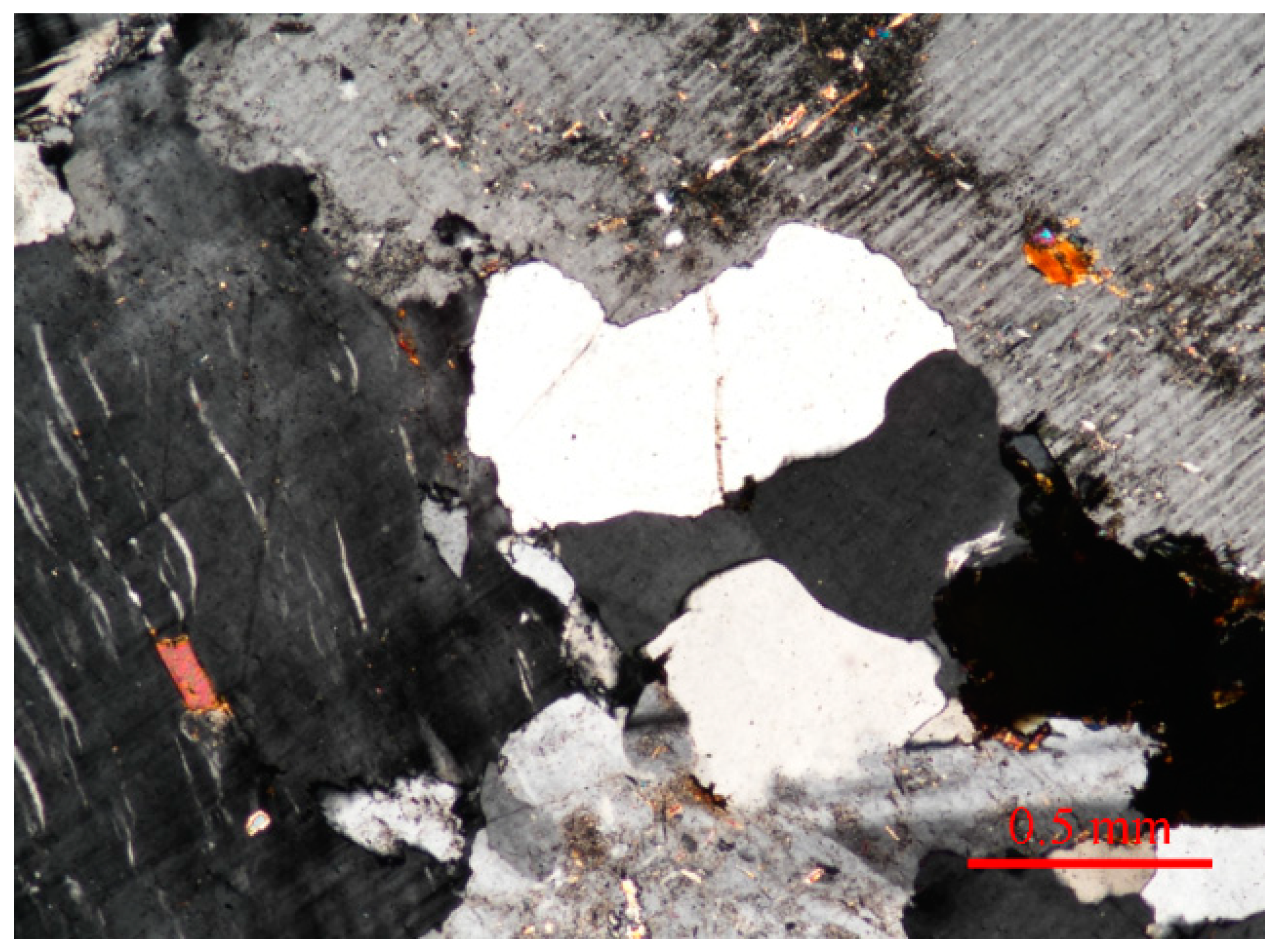
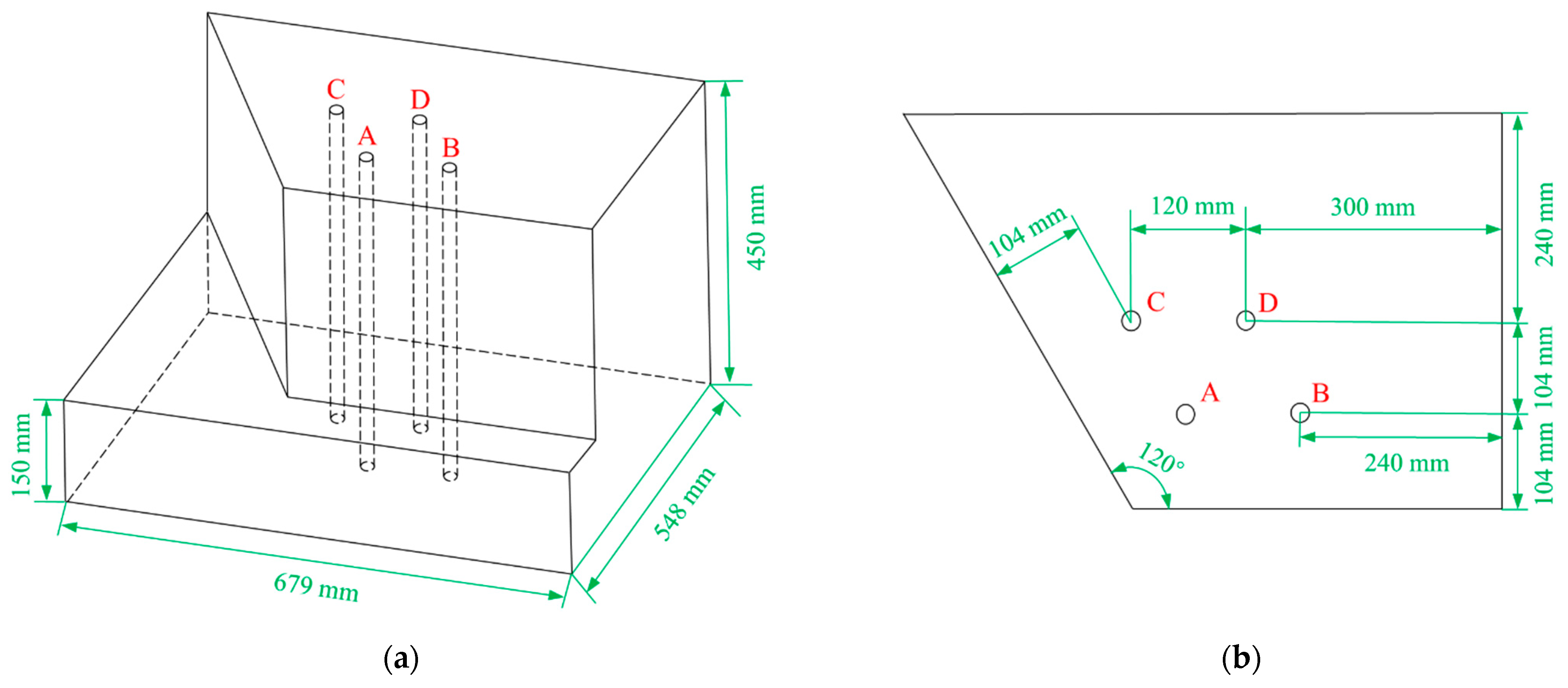
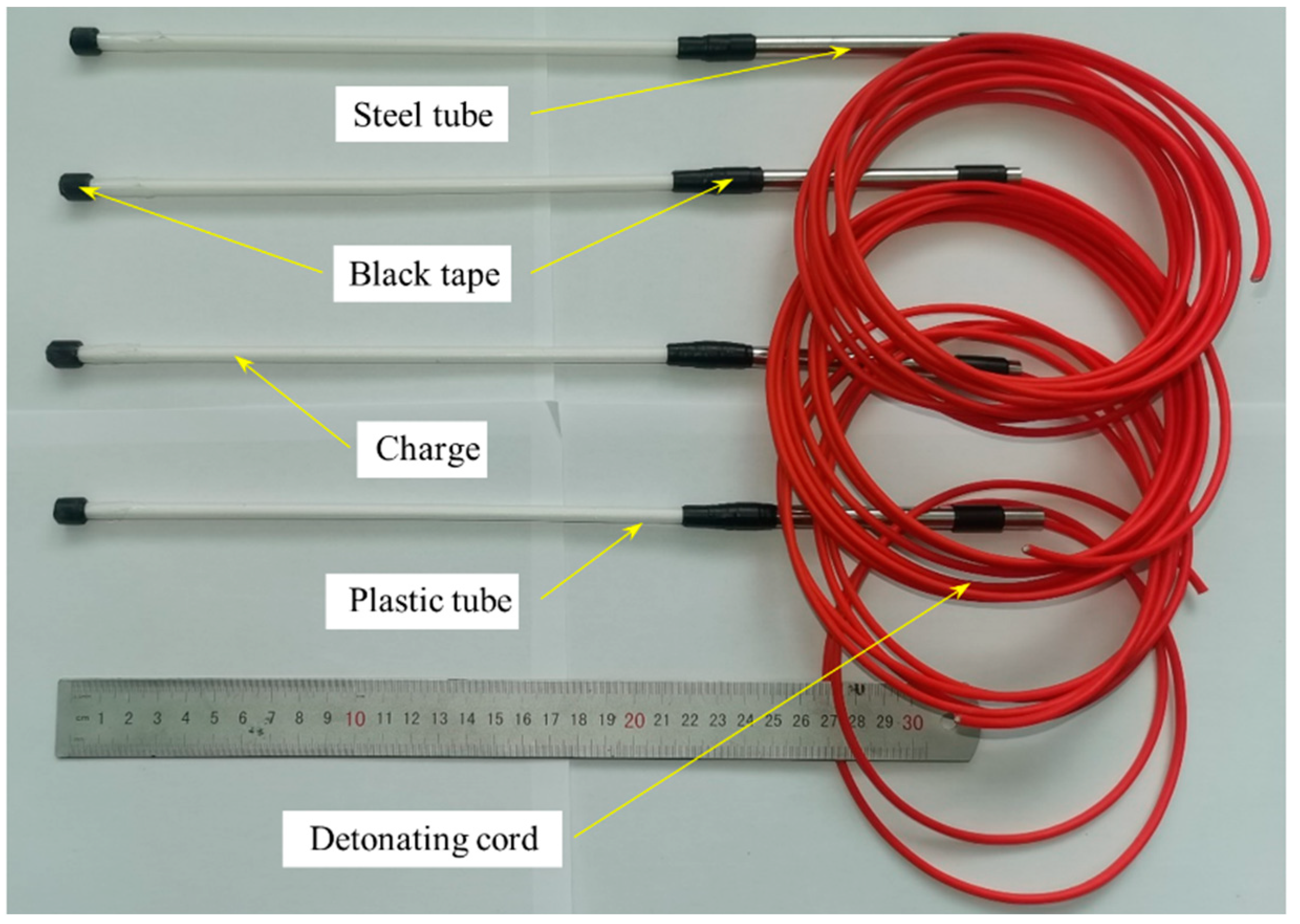
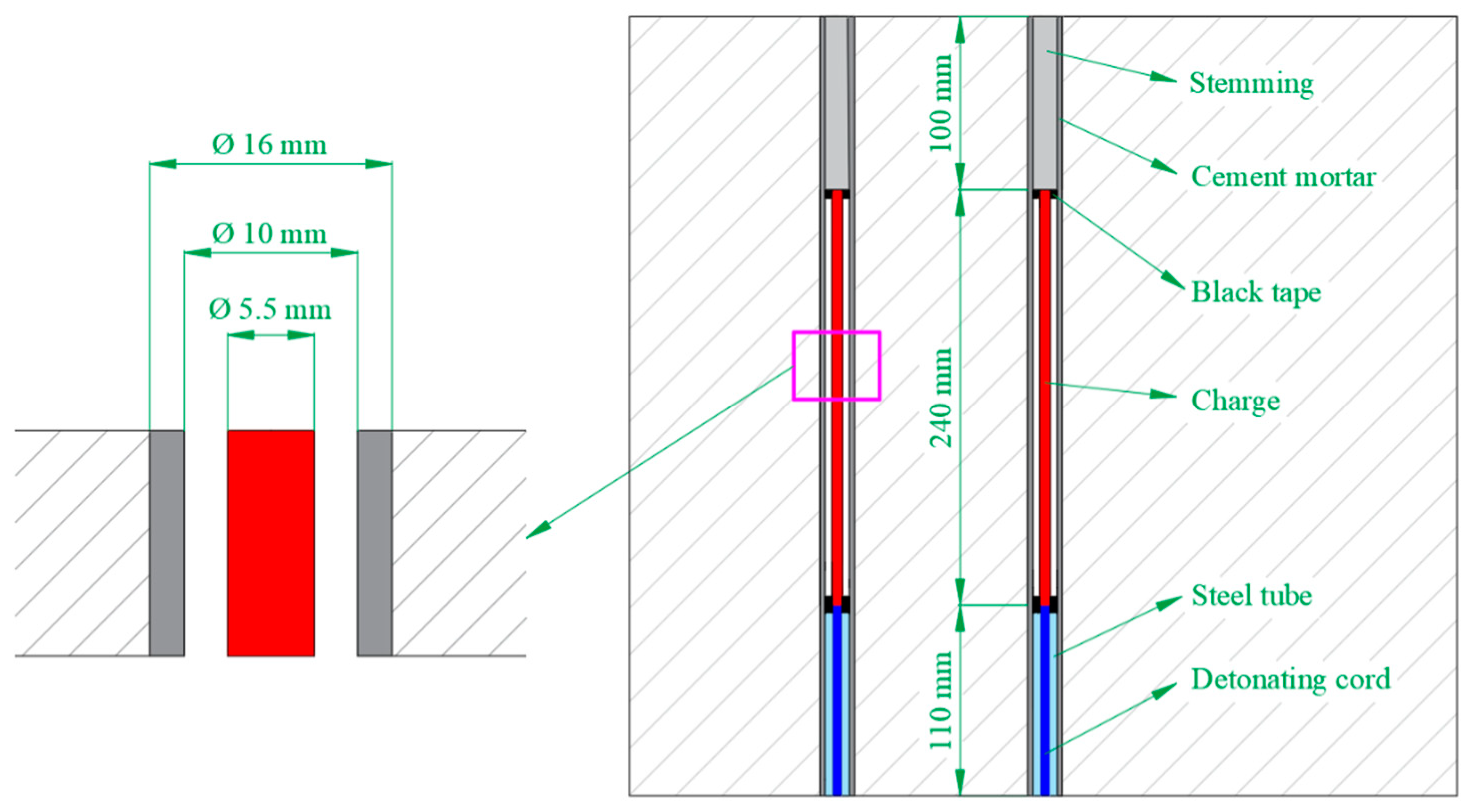

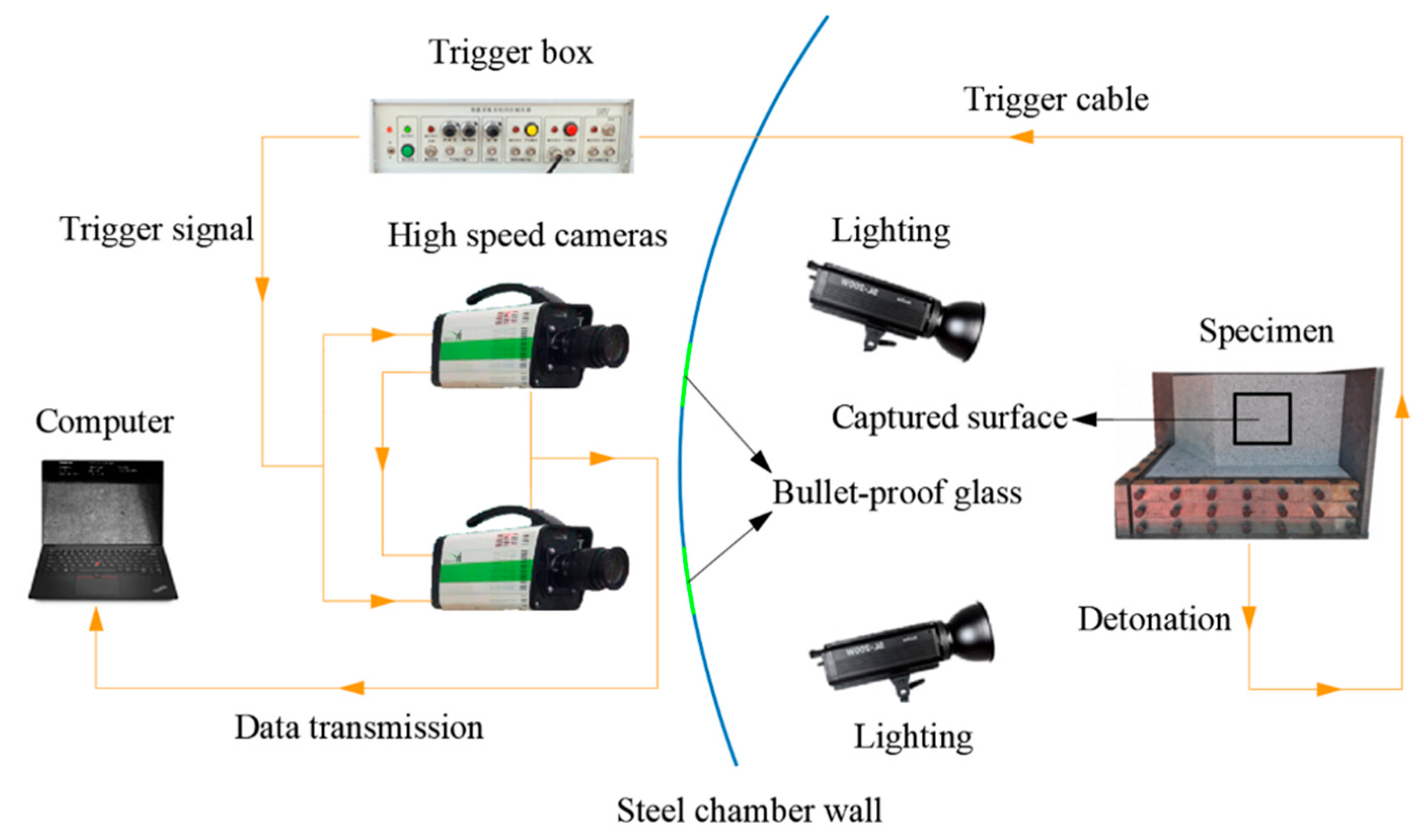

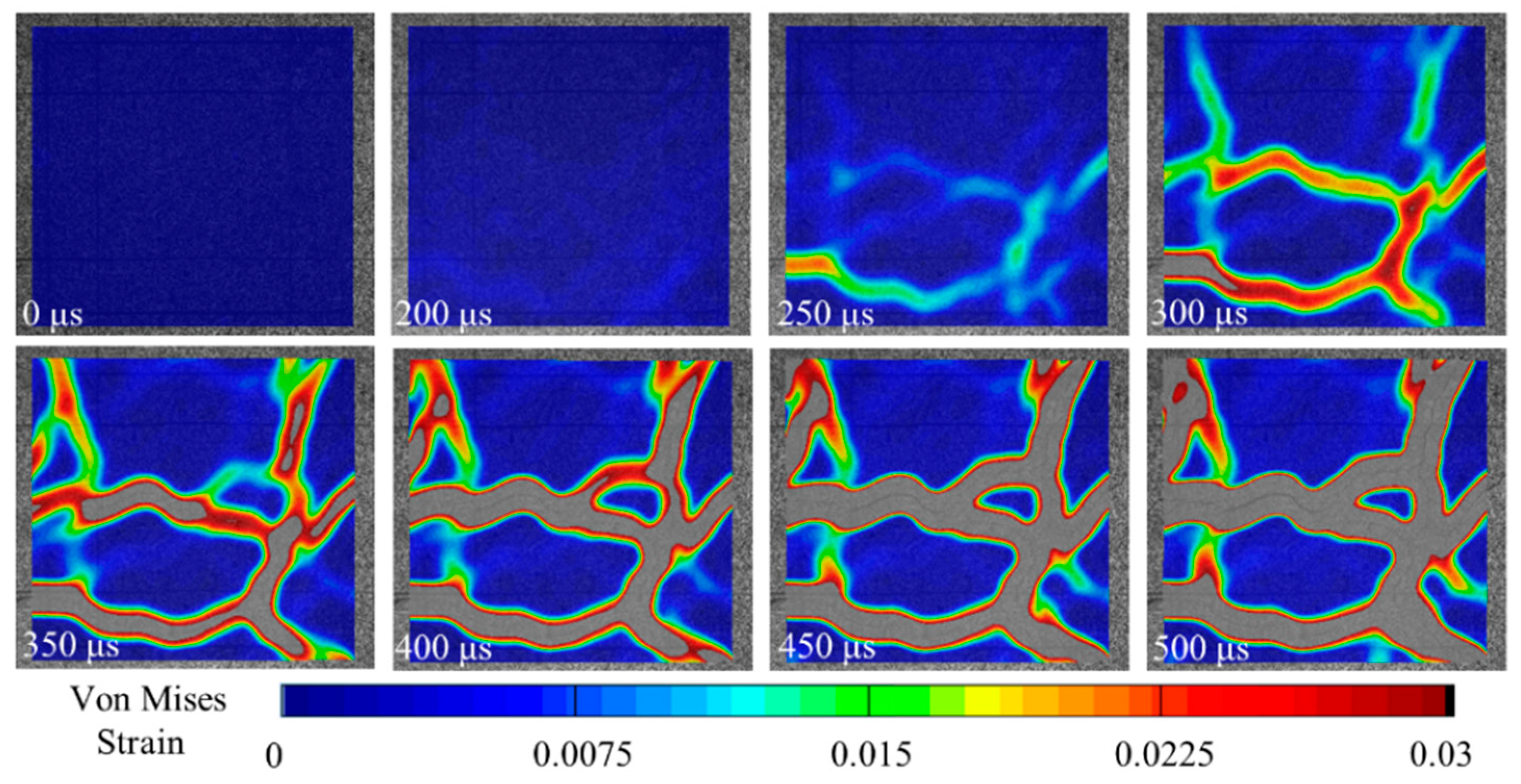
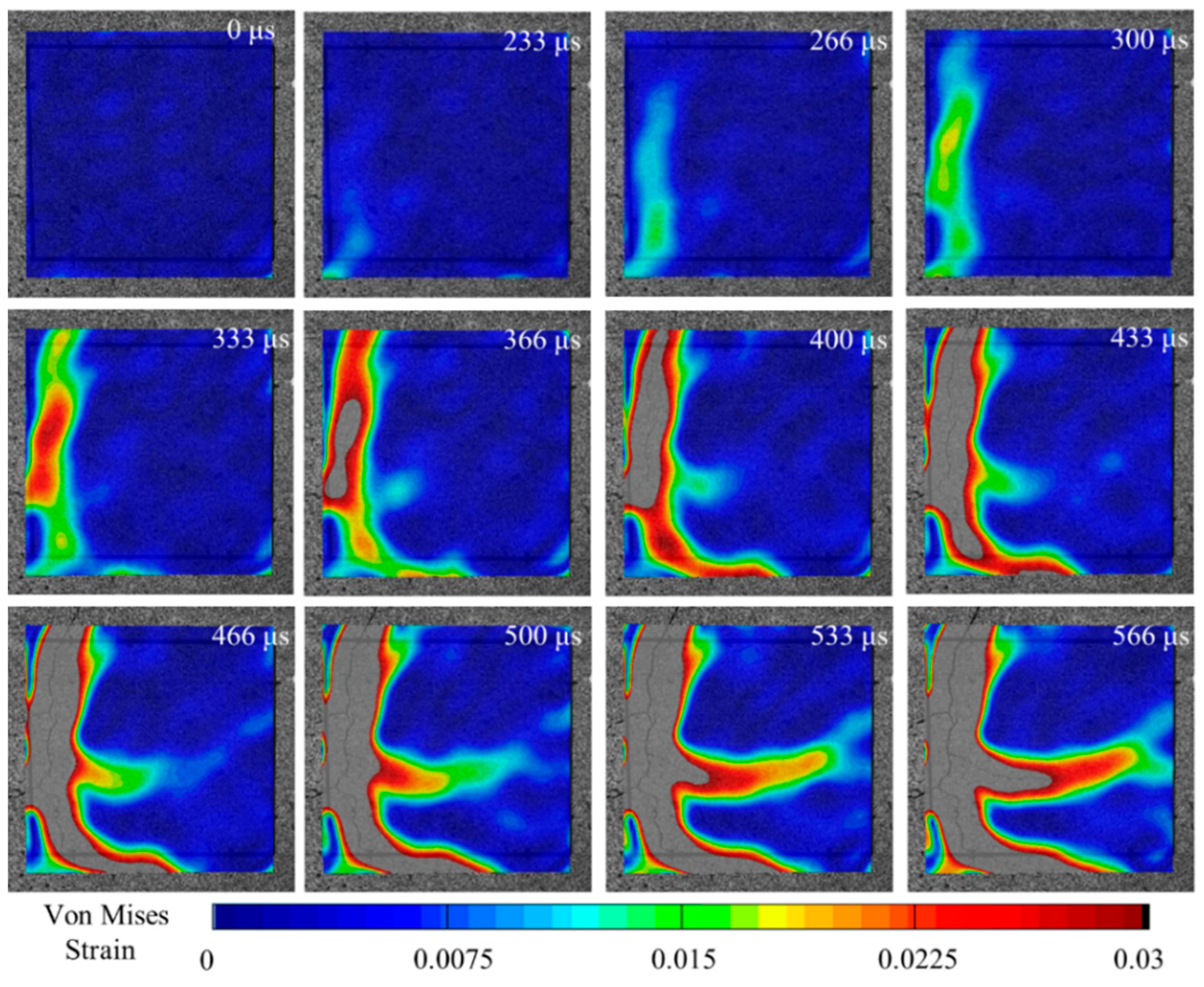

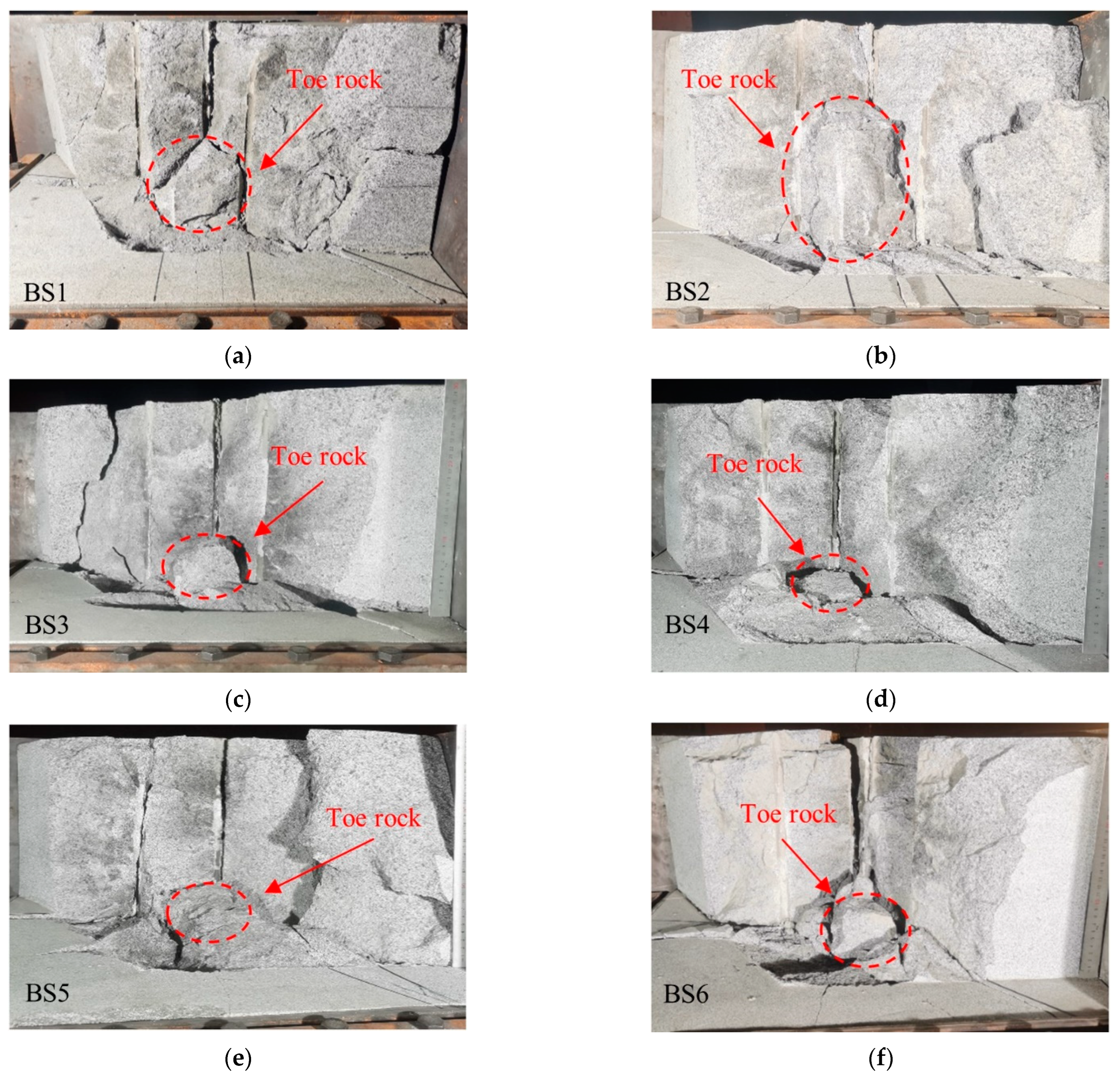
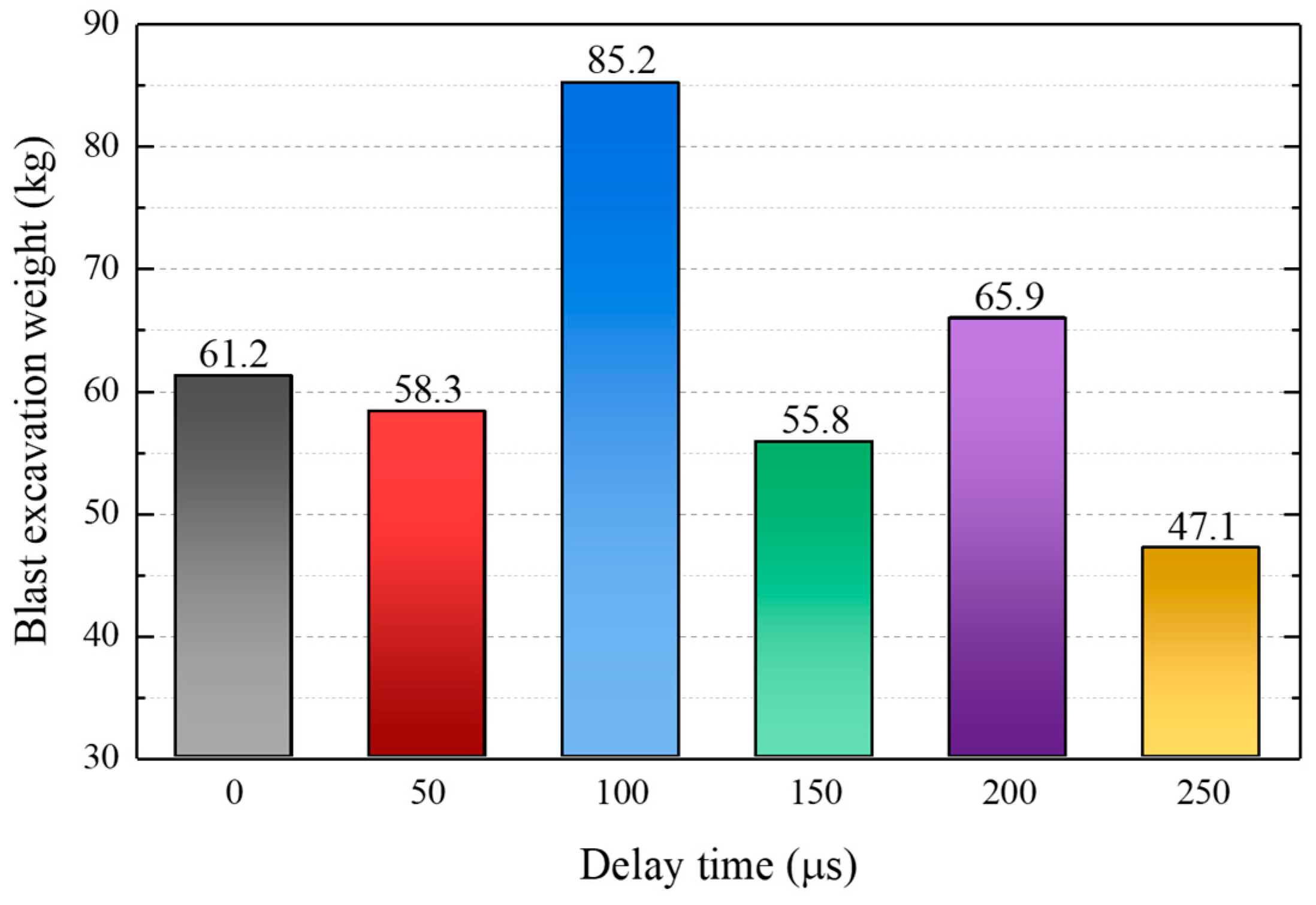
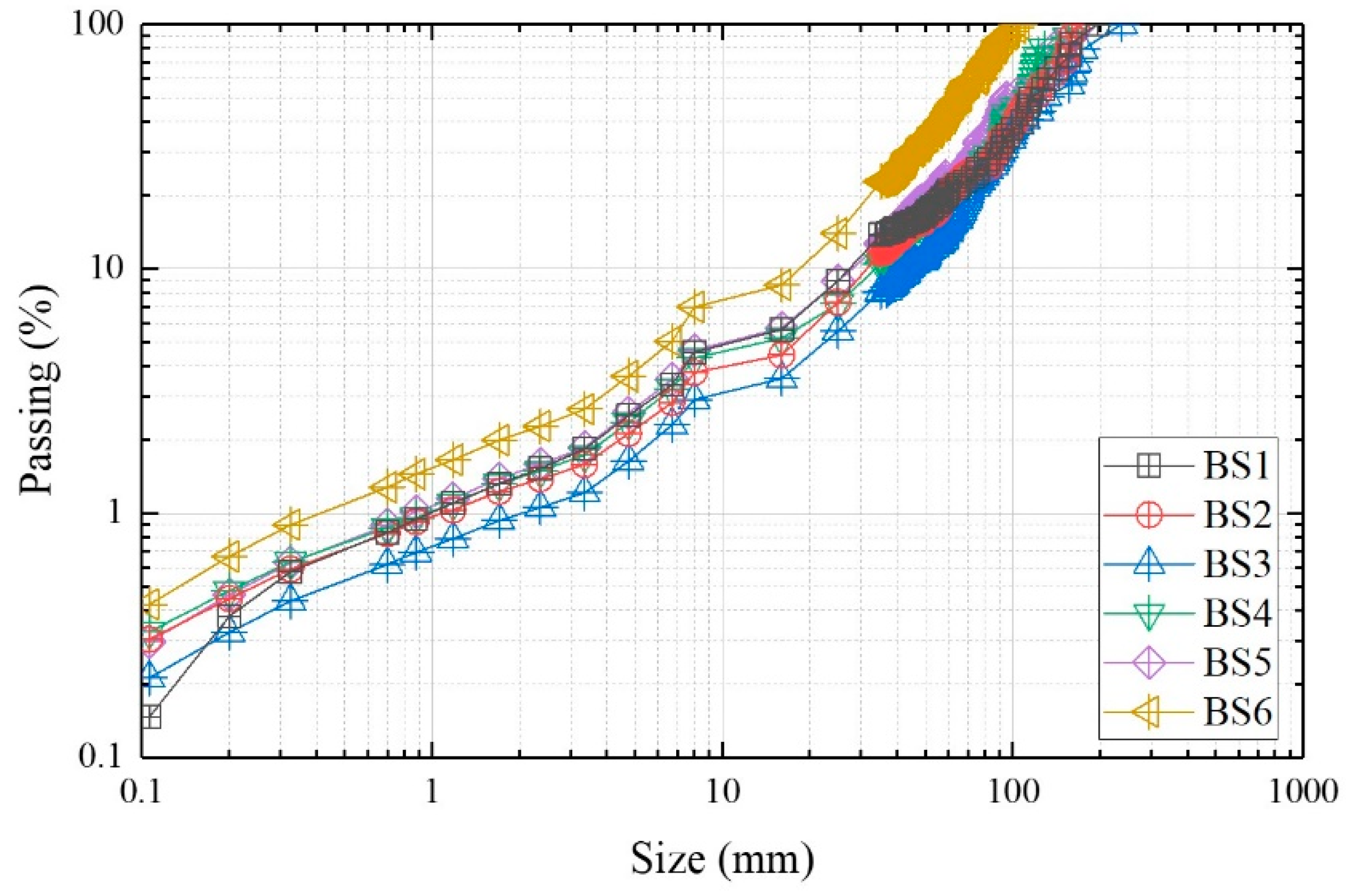


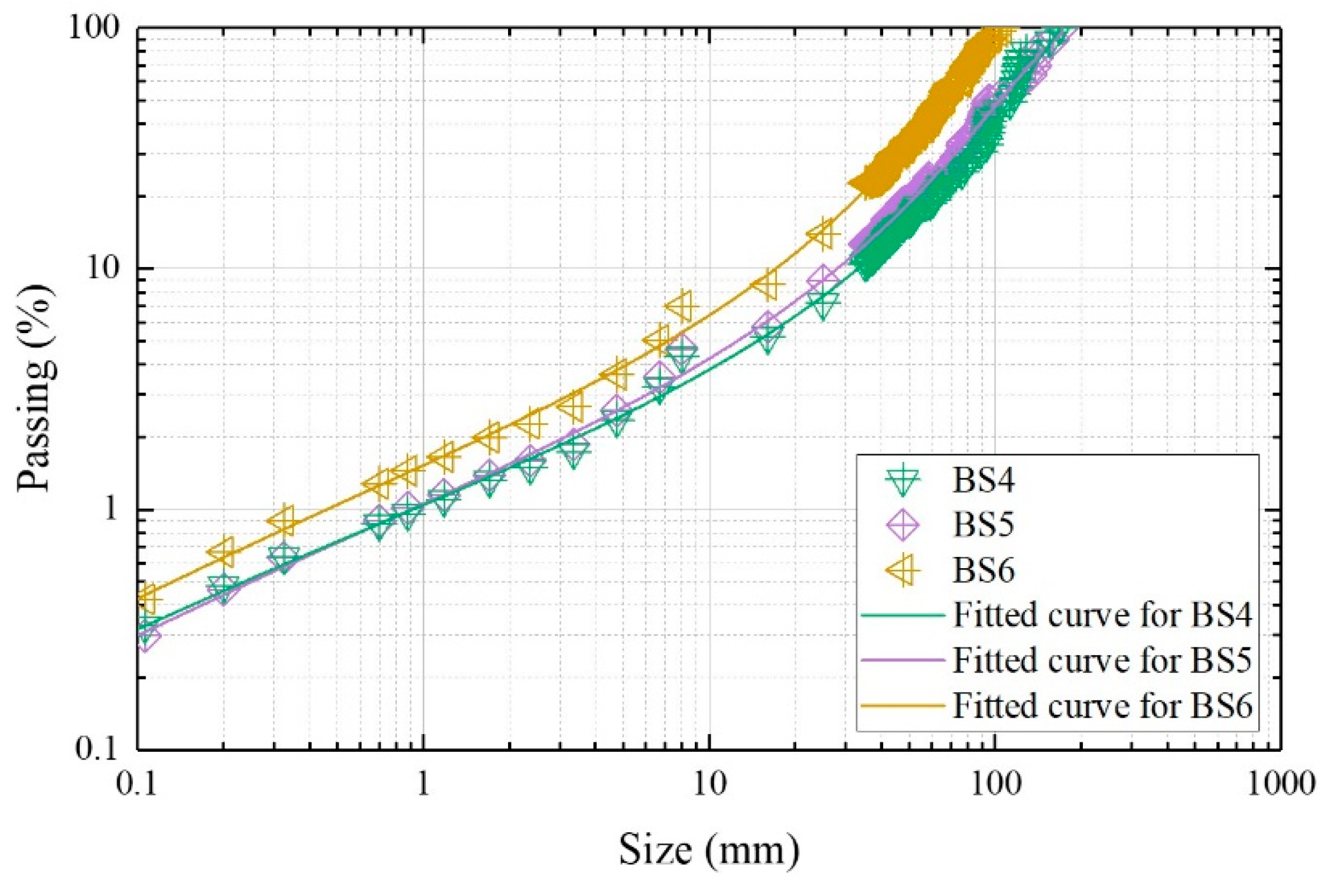
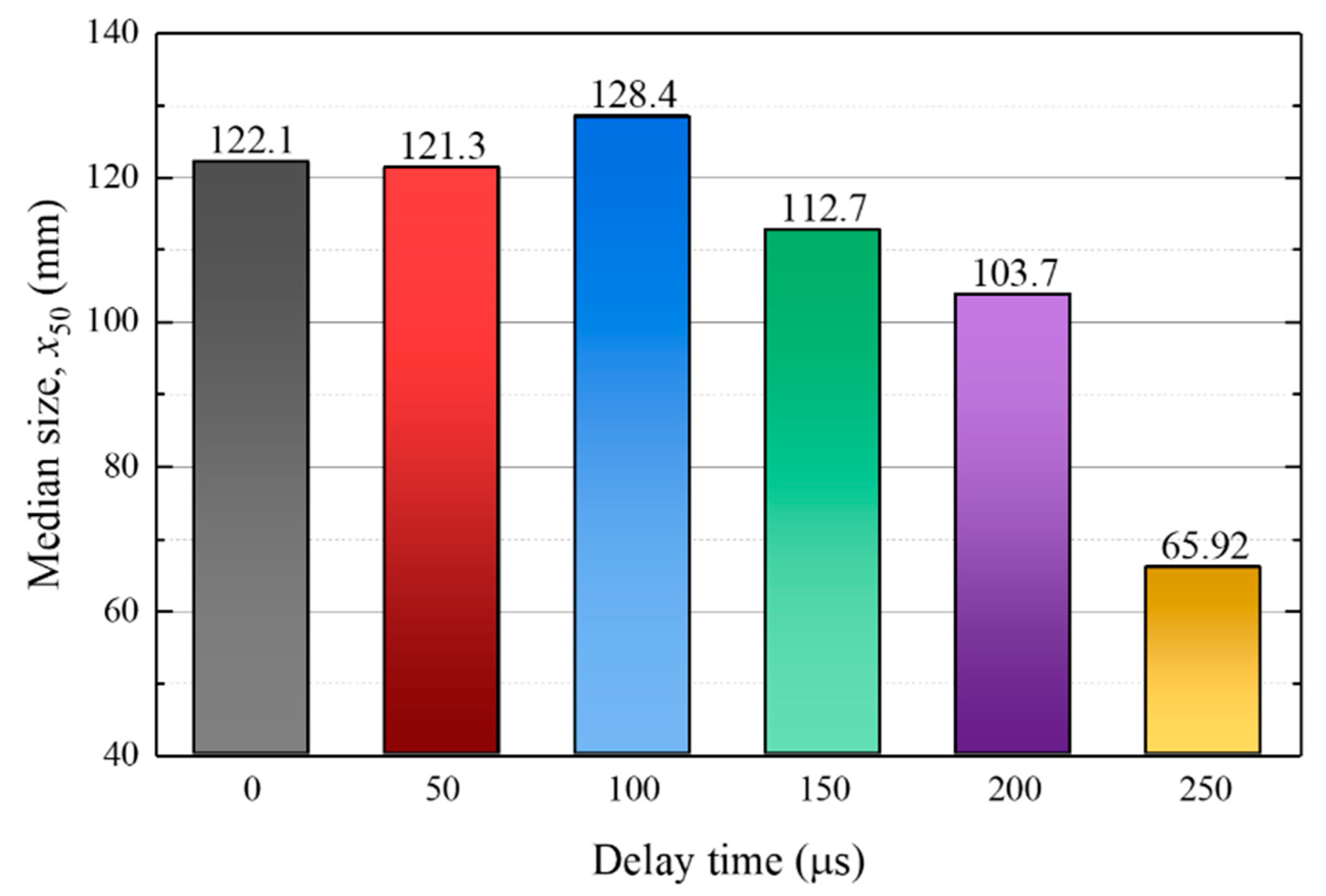
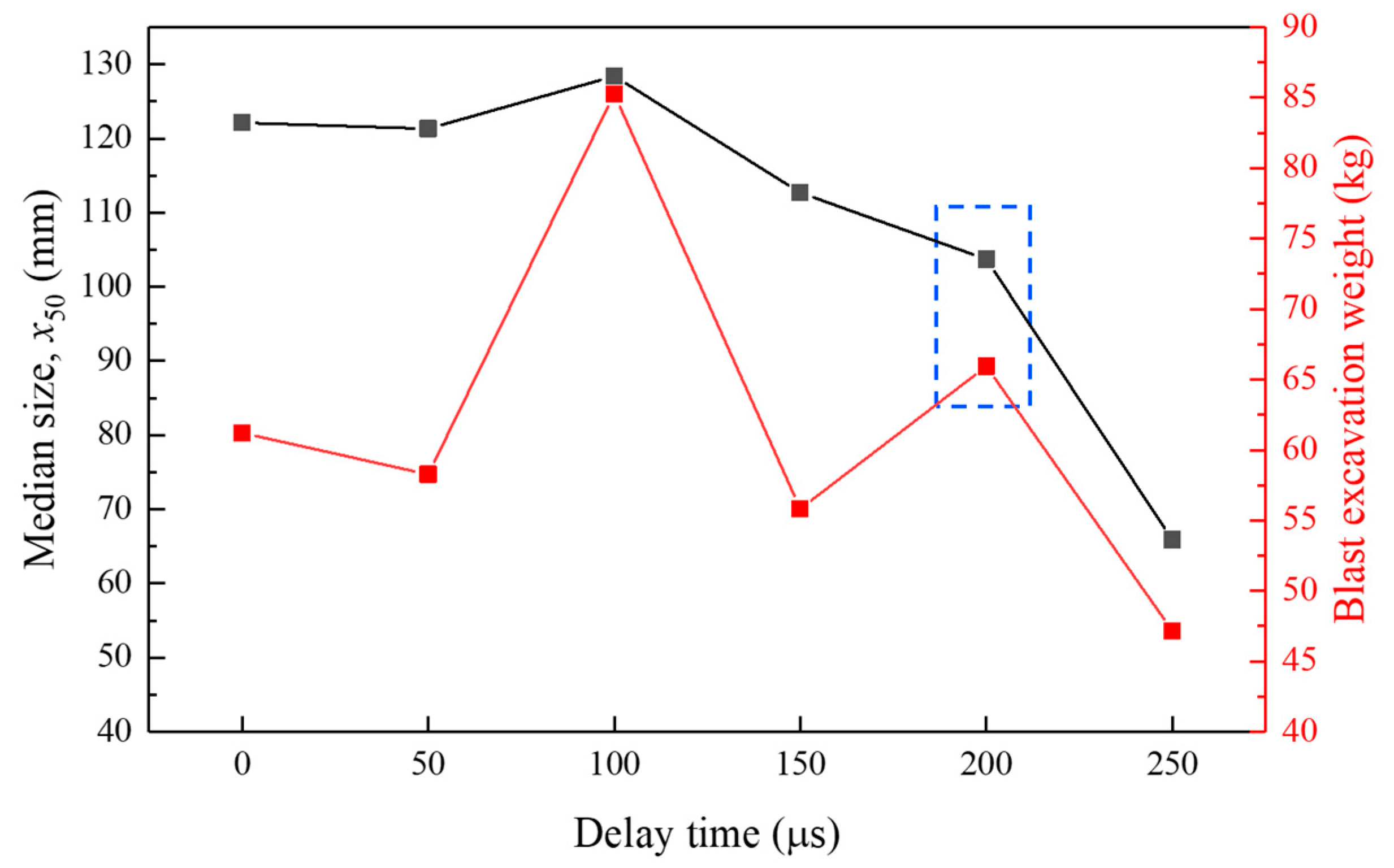

| Density (g cm−3) | Young’s Modulus (GPa) | Poisson’s Ratio | Uniaxial Static Compressive Strength (MPa) | Static Tensile Strength (MPa) | Longitudinal Wave Velocity (m s−1) |
|---|---|---|---|---|---|
| 2.61 | 13.69 | 0.21 | 69.08 | 5.65 | 3383 |
| Bench Specimen No. | Inter-Hole Delay (µs) | Charge Weight of A (g) | Charge Weight of B (g) | Charge Weight of C (g) | Charge Weight of D (g) |
|---|---|---|---|---|---|
| BS1 | 0 | 4.83 | 4.84 | 4.82 | 4.85 |
| BS2 | 50 | 4.84 | 4.85 | 4.86 | 4.86 |
| BS3 | 100 | 4.86 | 4.83 | 4.85 | 4.84 |
| BS4 | 150 | 4.85 | 4.83 | 4.84 | 4.86 |
| BS5 | 200 | 4.83 | 4.85 | 4.86 | 4.84 |
| BS6 | 250 | 4.84 | 4.86 | 4.83 | 4.84 |
| Bench Specimen No. | Inter-Hole Delay (μs) | xmax (mm) | x50 (mm) | a | b | c | R2 |
|---|---|---|---|---|---|---|---|
| BS1 | 0 | 195.4 | 122.1 | 0.4604 | 1.708 | 0.8526 | 0.9924 |
| BS2 | 50 | 166.3 | 121.3 | 0.1085 | 2.309 | 0.6165 | 0.9961 |
| BS3 | 100 | 237.1 | 128.4 | 0.8099 | 2.265 | 0.8727 | 0.9956 |
| BS4 | 150 | 167.4 | 112.7 | 0.4377 | 1.904 | 07194 | 0.9945 |
| BS5 | 200 | 171.5 | 103.7 | 0.4092 | 2.116 | 0.7438 | 0.9969 |
| BS6 | 250 | 105.7 | 65.9 | 0.4626 | 1.929 | 0.7543 | 0.9981 |
| Bench Specimen No. | Inter-Hole Delay (μs) | x1 (mm) | x10 (mm) | x50 (mm) | x100 (mm) |
|---|---|---|---|---|---|
| BS1 | 0 | 1.06 | 28.08 | 122.1 | 195.4 |
| BS2 | 50 | 1.14 | 31.72 | 121.3 | 166.3 |
| BS3 | 100 | 1.99 | 43.18 | 128.4 | 237.1 |
| BS4 | 150 | 0.92 | 33.12 | 112.7 | 167.4 |
| BS5 | 200 | 0.89 | 27.69 | 103.7 | 171.5 |
| BS6 | 250 | 0.46 | 17.05 | 65.9 | 105.7 |
Disclaimer/Publisher’s Note: The statements, opinions and data contained in all publications are solely those of the individual author(s) and contributor(s) and not of MDPI and/or the editor(s). MDPI and/or the editor(s) disclaim responsibility for any injury to people or property resulting from any ideas, methods, instructions or products referred to in the content. |
© 2023 by the authors. Licensee MDPI, Basel, Switzerland. This article is an open access article distributed under the terms and conditions of the Creative Commons Attribution (CC BY) license (https://creativecommons.org/licenses/by/4.0/).
Share and Cite
Tang, H.-L.; Yang, J.; Yu, Q. Experimental Investigation of the Effect of Delay Time on Rock Fragmentation in Multi-Hole Bench Blasting. Appl. Sci. 2023, 13, 7329. https://doi.org/10.3390/app13127329
Tang H-L, Yang J, Yu Q. Experimental Investigation of the Effect of Delay Time on Rock Fragmentation in Multi-Hole Bench Blasting. Applied Sciences. 2023; 13(12):7329. https://doi.org/10.3390/app13127329
Chicago/Turabian StyleTang, Hong-Liang, Jun Yang, and Qi Yu. 2023. "Experimental Investigation of the Effect of Delay Time on Rock Fragmentation in Multi-Hole Bench Blasting" Applied Sciences 13, no. 12: 7329. https://doi.org/10.3390/app13127329
APA StyleTang, H.-L., Yang, J., & Yu, Q. (2023). Experimental Investigation of the Effect of Delay Time on Rock Fragmentation in Multi-Hole Bench Blasting. Applied Sciences, 13(12), 7329. https://doi.org/10.3390/app13127329






